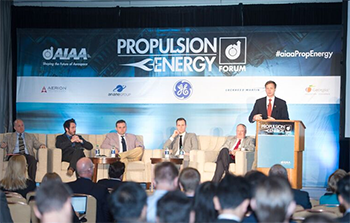Custom Propulsion Needed for Unmanned Aircraft Written 11 July 2017
Panelists: Moderator Matthew McCrink, Aerospace Research Center, The Ohio State University; Mike Armstrong, vision systems lead, Rolls-Royce North American Technologies; William J. Fredericks, founder and CEO, Advanced Aircraft Co.; Matt Hutchison, vice president of engineering, Aurora Flight Sciences; Jeremiah McNatt, Photovoltaic and Electrochemical Systems Branch, NASA’s Glenn Research Center; Joseph Valenzuela, senior business development executive, Tactical UAS, Kratos Defense & Security Solutions
by Tom Risen, Aerospace America staff reporter (2017-2018)

The unmanned aircraft sector is expanding to meet a wide range of military and commercial tasks, and custom building propulsion for those types of craft could optimize that potential, a panel of executives said July 10 during the “UAS Power Generation and Storage” session at the 2017 AIAA Propulsion and Energy Forum in Atlanta.
Unmanned aircraft innovation has been driven by developments in electronics, miniaturization or autonomy rather than new propulsion technologies specifically for that market, so that is an area ripe for disruption, said Mike Armstrong, vision systems lead at Rolls-Royce North American Technologies. Armstrong added that the lack of industry standards for propulsion built specifically for unmanned aircraft is one obstacle facing that innovation, especially for electric propulsion.
The type of propulsion needed depends on the task it is built for, considering that size and weight are key factors in making a craft cost-effective, said William Fredericks, CEO of Advanced Aircraft Co. Ability to survey land is key for tasks like precision agriculture, for instance, so the effectiveness of a drone’s battery would help meet the customer’s needs while cutting down the time needed for them to get a return on their investment, Fredericks said.
Designing the aerodynamics of an unmanned aircraft with a specific type of propulsion in mind could help reduce fuel costs and make it more cost-effective, said Matt Hutchison, vice president of engineering at Aurora Flight Sciences.
Lack of a business incentive to attract innovation by top engine providers, however, is a reason that efficient, effective propulsion has been “a major challenge,” particularly for small military unmanned aircraft, Hutchison said.
“It’s just not worth the investment required for them to get into that space,” Hutchison said, adding that advances in electric propulsion could spur investment.
Electric-powered engines could drive down costs for some unmanned aircraft, but they are likely not going to completely replace traditional gas-powered engines on conventional aircraft in the near future, Hutchison said. Electric aircraft will likely be most competitive in “niche applications” like urban mobility with vertical takeoff and landing craft as discussed during the Uber Elevate summit in April.
“This is competing against non-consumption, not competing against established players,” he said of the ability for electric-powered aircraft to meet such niche services.
